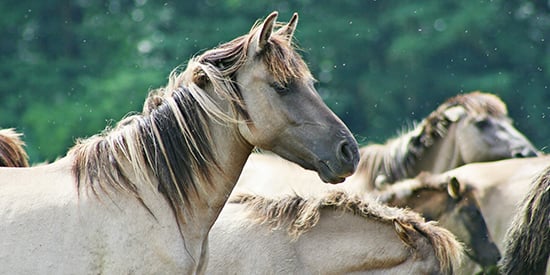Feral horses must be culled to fix destruction of Victorian Alps: Deakin ecologist
Media releaseA Deakin University ecologist has congratulated the State Government for releasing a plan to tackle feral horse numbers in Victoria's Alps, but said its recommendations didn't go far enough to eradicate the environmentally destructive animals.
Parks Victoria today released a draft of the 'Protection of Alpine National Park - Feral Horse Strategic Action Plan' for public comment.
Professor Don Driscoll, Director of Deakin's Centre for Integrative Ecology and President of the Ecological Society of Australia, said the plan fell short of instigating a culling program, something the scientific community have long said is needed.
"I do congratulate the government for recognising this is a problem that has to be fixed. The proposal to remove small populations completely from the Bogong High Plains and surrounding state forest is a critically important move that will protect the most vulnerable alpine ecosystem," Professor Driscoll said.
"This is a small step in the right direction, but it's a mistake not to consider culling as a control method."
Instead the State Government's plan recommends a trapping program, where horses are caught with the intention of re-homing.
Professor Driscoll said trapping alone was unlikely to significantly reduce feral horses, which number in their thousands in the Victorian Eastern Alps.
"Culling must be part of feral horse management, it's the only way to rapidly reduce horse numbers, and aerial culling is the most humane and effective method of doing so," Professor Driscoll said.
"Horses suffer very little stress before being put down by marksmen. This is in contrast to the main alternative of trapping horses and then transporting them out.
"Rounding up horses is one of the cruellest management approaches. Horses suffer extreme stress on long road journeys, and four out of five horses rounded up end up being sent to the abattoir anyway.
"It's also an expensive approach, and it hasn't worked in other areas. Horse numbers have continued to increase in Kosciuszko National Park, despite efforts to remove them in this way since 2008."
Professor Driscoll said it was critical the government started an aerial culling program, or at the very least implemented substantial ground-shooting methods, to rapidly reduce horse numbers within a few years.
"There were an estimated 2350 feral horses in the Victorian Eastern Alps at the time of the most recent survey in 2014 and horse populations can increase by up to 20 per cent each year," he said.
"By the time this plan is implemented, there could be more than four thousand feral horses."
The Victorian Government's plan proposes to remove up to 1200 horses over three years, suggesting this would reduce horse numbers by half.
But Professor Driscoll said that must assume a "courageously low" rate of population growth.
"Feral horses need to be taken out of Victoria's national parks as quickly as possible to protect Australia's natural heritage," he said.
"It's well established that feral horses degrade the alpine environment. And with such obvious and well-documented impacts on vegetation and streams, feral horses are likely to drive already threatened species - like the Guthega skink and Broad-toothed rat - closer to extinction.
"Victoria has only 17 per cent of its land set aside in reserves, so nature has already been massively compromised in the state.
"With such a small proportion of the land protected, all nature reserves should be exclusively for protecting native Australian species, and places where Australians can enjoy our natural heritage.
"Horses and other introduced species can occupy the majority of the state that is not part of the reserve system. There are solutions to celebrating the 'Man from Snowy River' culture that don't involve having horses in sensitive alpine ecosystems."

